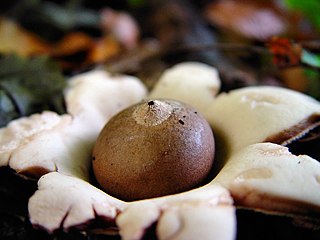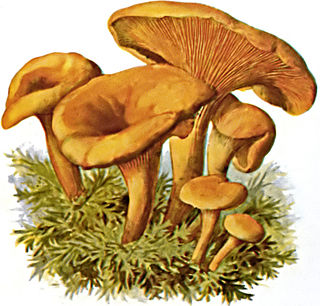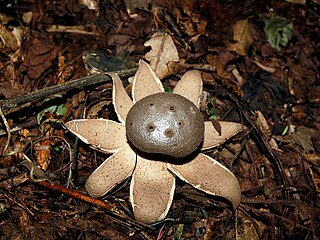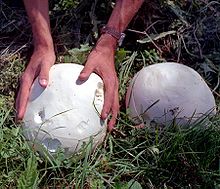
Geastrales is an order of gasterocarpic basidiomycetes (fungi) that are related to Cantharellales. The order contains the single family Geastraceae, which includes the "earthstars" formerly placed in Lycoperdales, or Phallales.

The Hygrophoropsidaceae are a family of mushrooms that are gilled in appearance but lie within the Boletales. The family contains 18 species within two genera: Leucogyrophana and Hygrophoropsis, with the best-known member being the "false chanterelle", Hygrophoropsis aurantiaca. Hygrophoropsidaceae was circumscribed by French mycologist Robert Kühner in 1980, with Hygrophoropsis as the type genus. Unlike most members of the Boletales, Hygrophoropsidaceae species are saprophytic wood-rotting fungi that cause brown rot in their hosts. The genera Austropaxillus and Tapinella, once placed in this family, are now classified in the Serpulaceae and Tapinellaceae, respectively.
Cyttariales are an order of ascomycete fungi. Many of them cause serious plant diseases. The order contains one family, two genera, and 11 species.

The Taphrinomycetes are a class of ascomycete fungi belonging to the subdivision Taphrinomycotina. It includes the single order Taphrinales, which includes 2 families, 8 genera and 140 species.

The Bankeraceae are a family of fungi in the order Thelephorales. Taxa are terrestrial, and ectomycorrhizal with plant species in families such as Pinaceae or Fagaceae. The family was circumscribed by Marinus Anton Donk in 1961. According to a 2008 estimate, the family contains 6 genera and 98 species.

The Leotiaceae are a family of fungi in the order Leotiales. Species in this family are saprobic, and have a wide distribution, especially in temperate regions. The family contains 7 genera and 34 species.

The Bulgariaceae are a family of fungi in the order Helotiales. Species are found in northern and southern temperate regions. The family contains four genera and seven species.

The Lachnocladiaceae are a family of fungi in the order Russulales. A 2008 estimate places 124 species in 8 genera in the Lachnocladiaceae. Species of this family, which have a widespread distribution in both tropical and temperate zones, are typically found on decaying coniferous or deciduous wood. The family was circumscribed by British mycologist Derek Reid in 1965.

The Peniophoraceae are a family of fungi in the order Russulales. Species of this family have a cosmopolitan distribution and are mostly saprobic, causing rots of standing and fallen wood. According to a 2008 estimate, the family contains 7 genera and 88 species.

The Pyxidiophorales are an order of fungi in the class Laboulbeniomycetes. The order was created in 2001 to contain the single family Pyxidiophoraceae, circumscribed in 1971. The Pyxidiophoraceae are mostly coprophilous fungi that associate with mites and other arthropods. The type genus, Pyxidiophora, the largest genus of the family, has about 20 species.

The Choanephoraceae are a family of fungi in the order Mucorales. Members of this family are found mostly in the tropics or subtropics, and only rarely in temperate zones. The family currently includes species formerly classified in the family Gilbertellaceae.

Myriostoma is a fungal genus in the family Geastraceae. Basidiocarps resemble earthstars, but the spore sac is supported by multiple columns and has multiple ostioles instead of a single, apical ostiole. Until 2017, the genus was thought to be monotypic with a single, widespread species, Myriostoma coliforme. Recent research has, however, shown that at least six species occur worldwide.
Gelopellis is a genus of fungi in the family Claustulaceae. The species in this relatively rare genus have fruit bodies that resemble the unopened egg of Mutinus, with the columnella occupying the place where the compressed receptacle would be in the latter genus. The genus contains six species found in South America, Japan, and Australia.

The Sarcosomataceae are a family of fungi in the order Pezizales. According to a 2008 estimate, the family contains 10 genera and 57 species. Most species are found in temperate areas, and are typically saprobic on rotten or buried wood.
The Acaulosporaceae are a family of fungi in the order Diversisporales. Species in this family are widespread in distribution, and form arbuscular mycorrhiza and vesicles in roots. The family contains two genera and 31 species.

The Exobasidiaceae are a family of fungi in the division Basidiomycota, order Exobasidiales. The family contains 5 genera and 56 species. Species in the family have a widespread distribution, especially in temperate areas. Members of the Exobasidiaceae are plant pathogens that grow on the leaves of plants, especially those in the family Ericaceae.

The Chaconiaceae are a family of rust fungi in the order Pucciniales. The family contained 8 genera and 75 species in 2008. By 2020, there were 8 genera and 84 species.
The Microthyriales are an order of sac fungi. According to a 2008 estimate, the order contains 3 families, 62 genera and 323 species. Species in the Microthyriales have small, flattened fruit bodies with one of more central slits, and are saprobic or epiphytic on the leaves and stems of plants.

Gummivena is a fungal genus in the Mesophelliaceae family. The genus is monotypic, containing the single truffle-like species Gummivena potorooi, found in Western Australia. Described as new to science in 2002, Gummivena is intermediate in form between Castoreum and Gummiglobus, and has a gleba with "veins" of gummy tissue and a three-layered peridium. The specific epithet potorooi refers the fact that the fungus is found only in the range of the rare and endangered species Gilbert's potoroo.

Sclerodermatineae is a suborder of the fungal order Boletales. Circumscribed in 2002 by mycologists Manfred Binder and Andreas Bresinsky, it contains nine genera and about 80 species. The suborder contains a diverse assemblage fruit body morphologies, including boletes, gasteroid forms, earthstars, and puffballs. Most species are ectomycorrhizal, although the ecological role of some species is not known with certainty. The suborder is thought to have originated in the late Cretaceous (145–66 Ma) in Asia and North America, and the major genera diversified around the mid Cenozoic (66–0 Ma).
















